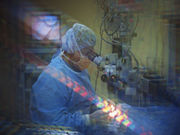BPS induces lipid accumulation and differentiation of primary human preadipocytes
WEDNESDAY, March 23, 2016 (HealthDay News) — Bisphenol S (BPS) induces adipogenesis in primary human preadipocytes, according to a study published online March 22 in Endocrinology.
Jonathan G. Boucher, from the Environmental Health Science and Research Bureau at Health Canada in Ottawa, and colleagues examined the effects of BPS on adipogenesis in primary human preadipocytes. They quantified lipid accumulation and mRNA and protein levels of key adipogenic markers after treatment with BPS at concentrations ranging from 0.1 nM to 25 µM.
The researchers found that treatment of preadipocytes with 25 µM BPS induced lipid accumulation and correlated with increases in mRNA and protein levels of several adipogenic markers, including lipoprotein lipase and adipocyte protein 2 (aP2). BPS-induced lipid accumulation was inhibited by cotreatment of cells with the estrogen receptor antagonist ICI-182,780, which also affected aP2, but not lipoprotein lipase protein levels. No effect was seen on BPS-induced lipid accumulation or protein levels with cotreatment of cells with the glucocorticoid receptor antagonist RU486. BPS was able to activate peroxisome proliferator-activated receptor-γ (PPARG) based on reporter gene assays using a synthetic promoter containing PPARG-response elements and a PPARG-responsive human aP2 promoter region.
“To our knowledge, this study is the first to show that BPS induces lipid accumulation and differentiation of primary human preadipocytes, and this effect may be mediated through a PPARG pathway,” the authors write.
The study was supported by the Health Canada Chemical Management Plan.
Copyright © 2016 HealthDay. All rights reserved.








